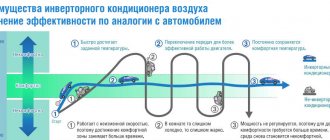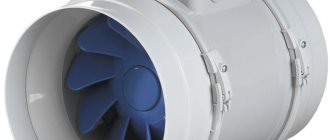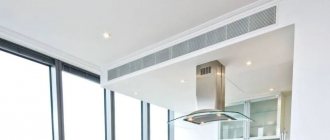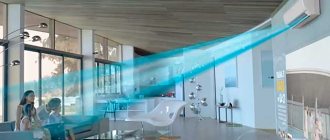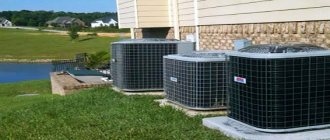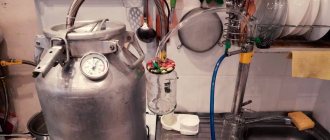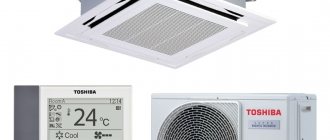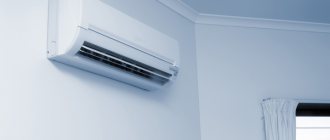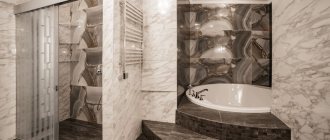Duct air conditioners are not as widespread as conventional air conditioners, and probably eight out of ten people will firmly say that this is a device for cooling the air. But in reality, the air conditioning system is designed to maintain certain microclimate standards in the building. Translated from the English word “conditions”, this word means condition or condition.
It is generally accepted that the main function of products of this type is air cooling. This air conditioner allows you to use all the advantages of air conditioning, in other words, to have complete control over the microclimate of the air mass in your home.
What is a ducted air conditioner
A duct air conditioner is a device for moving outside air through air ducts. It can be used for one room of different sizes or several rooms at once. All duct-type air conditioners, consisting of external and internal elements, are connected to each other by refrigerant pipes and electrical cables.
The indoor unit has a simple design and, usually, it and the air ducts with cables have to be hidden behind the cladding.
Wall chipping
Wall chipping in concrete/monolith
Grooving walls for freon communications 70x40 cm. (concrete) M.p.1 500 Grilling a wall for drainage communications 25x25 cm. (concrete) M.p. 800 Grilling a wall for an electric cable 15x15 cm. (concrete) M.p. 500 Grilling a wall for a niche for drainage pump 150x70 cm (concrete) pcs. 600Wall chipping in brick
Grilling of walls for freon communications 70x40 (brick) M.p.1 300 Grilling of a wall for drainage communications 25x25 (brick) M.p.600 Grilling of a wall for an electric cable 15x15 cm (brick) M.p.500 Grilling of a wall for a niche for a drainage pump 150x70 cm (brick) pcs. 500Wall chipping in foam block/aerated concrete
Grilling of walls for freon communications 70x40 (aerated concrete) M.p.900 Grilling of a wall for drainage communications 25x25 (aerated concrete) M.p.500 Grilling of a wall for an electric cable 15x15 cm (aerated concrete) M.p.300 Grilling of a wall for a niche for a drainage pump 150x70 cm (aerated concrete) pcs. 400Holes in the wall
Additional drill hole Ø 50 mm in the wall up to 120 cm.Pcs. 700 Additional drill hole Ø 50 mm in the wall up to 100 cm.Pcs. 500 Additional drill hole Ø 50 mm in the wall up to 30 cm.Piece 400Design elements
The external unit contains all the main components of the refrigeration unit necessary for the smooth operation of the air conditioner. These include a compressor, throttle devices and a condenser heat exchanger with a fan to cool it.
When the atmosphere cools, a lot of moisture is formed and to remove it, a drain pump is installed in some models. Cold air is sucked in from outside, filtered to prevent foreign particles and dust from entering, and heated.
To ensure uninterrupted operation, the external unit contains additional devices in the form of valves, an automation system, various sensors for measuring environmental readings, as well as an electronic warning system for malfunctions in the duct air conditioner.
The outdoor unit is located on the wall, in a place protected from sunlight or below on an equipped area and protected from precipitation (rain and snow). When installing a duct device, you must comply with the technical specifications recommended in the instructions, the distance between the indoor and outdoor units, and take into account their height (so that there is no difference).
A block located indoors contains a minimum number of elements. They are presented in the form of a heat exchanger and a fan in a compact housing, as well as copper tubes connecting the pipes of this housing and the air duct channels.
Through air ducts for ducted air conditioners, the air flow is forced by a fan into the indoor unit and distributed among the channels. The housing, depending on the model, may also contain several sensors, a thermometer and an alarm.
Advantages and disadvantages in comparison
Duct systems are popular with everyone who cares about a comfortable atmosphere inside the house and at the same time tries not to expose all communications.
Experts in the field of air conditioning and regular users note the following advantages in using duct equipment:
- there is no internal wall unit, which requires space on the wall and often does not fit into the interior design;
- installation of the system ensures good air exchange in all rooms of the house;
- a powerful indoor unit can serve several small rooms;
- Noise from operating elements is reduced as much as possible.
When installing a duct system, you can combine it with ventilation, while saving on both the purchase of equipment and installation.
Modern air conditioning systems have different controls, but the most convenient way is to use the remote control. Using it you can select a mode, change the internal temperature, adjust the fan speed
But there are also disadvantages that sometimes persuade home owners to install traditional wall-mounted split systems that are no less efficient, but easier to install.
The disadvantages include:
- complex, requiring additional knowledge and professionalism, installation;
- arrangement of suspended structures to mask channels;
- it is impossible to create different temperature conditions in neighboring rooms - the temperature will be the same everywhere.
But the main problem seems to be competent design, selection, calculation and installation of the structure. It is clear that these are additional costs, and considerable ones. If the system is installed incorrectly, the minimum nuisance will be loud noise echoing throughout the house, and the maximum nuisance will be an expensive remodel.
Principle of operation
The operation of a duct air conditioner is no different from the operation of any others in this series. In a closed circuit there is a special gas (refrigerant), a compressor and a heat pump. The compressor forces the gas to move around the circuit. The movement of warm air occurs due to sequential compression and expansion of gas.
Air compression occurs in the external radiator of the system, as a result of which its temperature rises sharply. Due to the temperature difference, heat exchange occurs between the external cold air mass and the hot air space from the radiator, and to make the process more intense, an air flow from the fan is supplied to the external radiator.
The pressure in the radiator increases due to a throttle installed at the outlet - a special device that is capable of passing a measured air stream. Therefore, air gradually accumulates in front of the throttle and is forced to compress.
Option for installing a ducted air conditioner
A capillary tube is used as a throttle and it is selected to such a length that the gas turns into condensate (liquid) upon cooling. At the same time, it generates a lot of heat, and accordingly, the role of the heat pump increases significantly.
Through the throttle tube, gas gradually seeps into the radiator, which is located indoors. The atmospheric pressure here is low, and therefore the liquid is converted back into gas. Of course, it would be more correct to call the internal radiator an evaporator.
It turns out that a small volume of gas fills the entire capacity of the evaporator, that is, it expands. In this regard, the gas cools down and is immediately heated by the air pumped by the fan inside the room.
When heated, the gas begins to move and ends up in the compressor, which again pumps it into the external radiator and then the cycle repeats again.
Air duct calculation
The calculation of a ducted air conditioning system is quite complex and should only be entrusted to qualified specialists. In short, the procedure looks like this:
- For each room, a thermal calculation is made, on the basis of which the required refrigeration capacity is determined.
- The cooling capacity determines the approximate volume of cooled air that the air conditioner should supply to a given room. For models with a cooling capacity of up to 20 kW, approximately 165 cubic meters of air must be supplied to provide 1 kW of air. m/h, for more powerful ones (up to 40 kW) this figure is about 135 cubic meters. m/h.
Knowing the diameter of the air ducts, the material and the speed of air movement (it depends on the supply volume), the aerodynamic resistance of each branch and the entire system as a whole is determined.
Classification
Split systems are divided by power and the pressure created in the air ducts.
Duct low pressure air conditioners
Such duct air conditioners have a static air pressure of up to 40 Pa, and the best option for installing such a device would be to mount it behind the facing panels of the hallway of a hotel room.
These air conditioners are also used in offices and domestic premises. The air mass for condensation is taken from the hallway or corridor, and in such devices the mixing of air from the street is not taken into account.
Medium pressure air conditioners
These devices have a static pressure of up to 100 Pa, they can take air through air ducts and from the bottom of the case through a panel with a decorated grille.
Such devices are equipped with pumps to remove condensate that accumulates during operation. Air conditioners provide for the supply of external air, which allows for full use of the circulation and air conditioning functions.
High-pressure duct air conditioners
Such air conditioners are designed to create a microclimate in the halls of restaurants, supermarkets, offices and a number of other similar establishments.
They have a static pressure of up to 250 Pa, and this allows the use of such ducted air conditioning devices not only in one room, but also in several rooms. In this case, intake and supply occurs through a network of air ducts.
Protective grill with installation
Anti-vandal grille with installation up to 3.0 kW (05/07/09 and 12, 18 BTU)
6,500 RURAnti-vandal grille (1000/600/500) pcs. 4 500 Installation of anti-vandal grille (1000/600/500) pcs. 2 000Anti-vandal grille with installation up to 10.0 kW (24/36 BTU)
8,700 RURAnti-vandal grille (1200/1000/700) pcs. 6,000 Installation of anti-vandal grille (1200/1000/700) pcs. 2,700Installation features
Installation of duct air conditioners is carried out sequentially, starting with the outdoor unit. Depending on the fasteners, the device can be mounted on wall brackets with a bolted connection. They are also installed on a specially made platform made of profile material.
The internal and external blocks for moving refrigerant in liquid and gaseous states are connected to each other by copper tubes, which are laid in heat-insulating sleeves. It is understood that for laying communication pipes and cables, appropriate holes are first made in the wall.
Installation of such split systems requires in addition the installation of the unit inside and the installation of air ducts of considerable length to ensure proper maintenance of the premises. In this case, it is necessary to take into account fire safety measures: for example, in industrial premises where there may be a fire, only galvanized products are used as air ducts.
The diameter of such pipes is selected based on the characteristics of the equipment and the size of the room. The main difficulty when installing a duct air conditioner is the installation of air ducts according to the developed scheme, taking into account the direction and movement of air. As a rule, they are laid along the ceiling and require 15 to 25 cm of ceiling space for placement.
For this reason, such air ducts are installed in buildings with high ceilings, and indoor units are installed in utility rooms where the ceiling height is not important. And it is provided with open access for maintenance by technical personnel. In apartments, duct-type air conditioners are rarely used due to relatively low ceilings.
Non-standard mounting of the outdoor unit
Dismantling and installation of double-glazed windows up to 180x80 cmPcs. 1,500 Dismantling and installation of double-glazed windows over 180x80 cm Pcs. 2,500 Dismantling and assembly of a ventilated facade (2 tiles 60x60 cm) Pcs. 3,000 Dismantling and assembly of 1 tile of a ventilated facade 60x60 cm. Pcs. 1,500 Non-standard fastening of the external block (stud/crossbeam) Pcs. .1 500 Vibration supports with installation (set of 4 pcs.) Pcs. 1 300Application area
Most often, split systems of this type are used in rooms with large volumes, or where it is undesirable for the indoor unit to be visible.
Basically, duct air conditioners exceed the power of traditional air conditioners, and therefore are used in industrial premises, administrative buildings, conference rooms, offices and large stores.
Split systems can not only renew the atmosphere, but also ionize and humidify the air, and using the function of adding fresh air, you can ensure instant freshness and purity of the air in the room.
Protective (shockproof) visor with installation
6,500 RURup to 5.0 kW (05/07/09 and 12, 18 BTU)
3,800 RURProtective visor (1000/550) pcs. 2 300 Installation of a protective visor (1000/550) pcs. 1 500Protective visor with installation up to 10.0 kW (24/36 BTU)
RUR 4,800. Protective visor (1000/625) pcs. 2 800 Installation of a protective visor (1000/625) pcs. 2 000Video description
Video example of installation and use of a supply air conditioner:
- In solving the problem of ensuring normal ventilation in spacious rooms - living rooms, halls, gyms - column-mounted supply split systems are suitable. They are distinguished by high productivity and better distribution of flows in space.
- Power, installation location, control type and other important parameters must fully comply with specific operating conditions.
Important! When choosing an air conditioner with ventilation, you need to familiarize yourself not only with its type of device and operating principle, but also carefully study the basic technical data - power, performance, range of set operating temperature and flow rate. It is important to first make sure that the model is suitable for the place where you plan to install it.
Prices
Premium class air conditioners:
- Daikin from 39,000 rub. Daikin Catalog | Price list
- Mitsubishi Electric RUB 35,000 Mitsubishi Electric Catalog
Business class air conditioners:
- Mitsubishi Heavy RUB 29,000 Mitsubishi Heavy Catalog
- Gree from RUB 17,800 Gree catalog
Budget class air conditioners:
- Ballu from 15,000 rub. Catalog Ballu
- Neoclima from 13,000 rub. Catalog Neoclima
To find out the exact price for implementing a project specifically for your apartment, call or send a request, describing the task.
There are several types of projects, especially popular recently, each with its own advantages and disadvantages.
The most inexpensive and common are wall-mounted split systems in every room.
Air filtration
For fine air purification I chose the Systemair FFR 200 cassette filter. I planned to use the following filter elements:
- class G3 BFR 200 Coarse. With a flow of 300 m3, the losses on the new filter are 20 Pa. Replacement is recommended at a pressure loss of 170 Pa.
- class F7 BFR 200 ePM1. With a flow of 300 m3, the losses on the new filter are 75 Pa. Replacement is recommended at a pressure loss of 250 Pa.
The latest BFR 200 ePM1 filter separates 60% of PM1 size particles (0.3 to 1 µm according to ISO 16890). And it has a very decent price of 98.00 EUR.
After a year of operation, I was puzzled by the issue of replacing the filters. I decided to look on the market to see what analogues there are.
Option 1 - buy filter material and sew the filter yourself.
- I took apart one old filter and made a pattern - sheet size 350x2000 mm.
- I ordered sheet filter material of the class For comparison, I took several different materials: NF300/1, NF400/P, NF500/PS
- Below is a photo of the material: Progressive density material. The outside is loose, the inside is very dense.
- The NF300 is very similar to what the original filter was made from. It bends easily and it is easy to sew a filter out of it.
- NF500/PS is very dense, even hard. It will not be possible to make something similar to the original out of it.
- NF400/P is just what you need
Option 2 - order the filter assembled.
- At the same time as the material, I ordered an assembled filter class according to the following specification FVK-233-233-300-4-F6/20.
The workmanship is excellent, it fits perfectly in the original FFR 200 case. I decided for myself that I would order it - this is a 2-3 times savings compared to the original.
Service
In order for the device to work properly, the following actions must be performed at certain intervals:
- Removing dirt from the condensate tray. It is also useful to check the condensate discharge tube for dirt and treat the evaporator with a disinfectant - due to the abundance of moisture and dust, bacteria, often pathogenic, like to multiply here.
- Checking the refrigerant pressure. This operation must be performed by service personnel.
Freon pressure is checked using special equipment
- Checking air ducts for dust and removing it if found.
- Cleaning the filter.
Cleaning the filter
If this is not done, the volume of air pumped through the evaporator will be significantly reduced. This will lead to the following consequences:
- the air conditioner will not be able to maintain the room temperature at the user-specified level;
- the device may fail due to overload;
- the evaporator will freeze from a lack of warm air, which is why water may leak out of the indoor unit after shutdown.
The frequency of maintenance work is indicated in the device manual.
